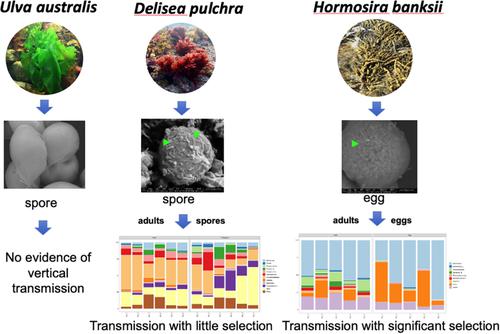当前位置:
X-MOL 学术
›
Environ. Microbiol.
›
论文详情
Our official English website, www.x-mol.net, welcomes your feedback! (Note: you will need to create a separate account there.)
Not all parents are the same: Diverse strategies of symbiont transmission in seaweeds
Environmental Microbiology ( IF 5.1 ) Pub Date : 2023-12-27 , DOI: 10.1111/1462-2920.16564 Syukur Syukur 1 , Joanna Richmond 2 , Marwan E. Majzoub 1 , Jadranka Nappi 1 , Suhelen Egan 1 , Torsten Thomas 1
Environmental Microbiology ( IF 5.1 ) Pub Date : 2023-12-27 , DOI: 10.1111/1462-2920.16564 Syukur Syukur 1 , Joanna Richmond 2 , Marwan E. Majzoub 1 , Jadranka Nappi 1 , Suhelen Egan 1 , Torsten Thomas 1
Affiliation

|
Different marine seaweed species have been shown to harbour specific bacterial communities, however, the extent to which vertical symbiont transmission from parents to offspring contributes to host-specificity is unclear. Here we use fluorescence and electron microscopy as well as 16S rRNA gene-based community analysis to investigate symbiont transmission in members of the three major seaweed groups (green Chlorophyta, red Rhodophyta and brown Phaeophyceae). We found seaweeds employ diverse strategies to transfer symbionts to their progeny. For instance, the green Ulva australis does not appear to have the capacity for vertical transmission. In contrast, the brown Phyllospora comosa adopts a non-selective vertical transmission. The red Delisea pulchra demonstrates weak selectivity in symbiont transmission, while the brown Hormosira banksii exhibits a strongly selective symbiont transfer. Mucilage on the gametes appears to facilitate vertical transmission and transferred bacteria have predicted properties that could support early development of the seaweeds. Previous meta-analysis has indicated that vertical transmission is rare in aquatic compared to terrestrial environments, however, our results contribute to the growing evidence that this might not be the case and that instead vertical transmission with various degrees of symbiont selection occurs in the ecologically important group of seaweeds.
更新日期:2023-12-27



























 京公网安备 11010802027423号
京公网安备 11010802027423号